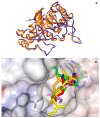Effects of Orally Consumed Rosa damascena Mill. Hydrosol on Hematology, Clinical Chemistry, Lens Enzymatic Activity, and Lens Pathology in Streptozotocin-Induced Diabetic Rats
- PMID: 31717650
- PMCID: PMC6891380
- DOI: 10.3390/molecules24224069
Effects of Orally Consumed Rosa damascena Mill. Hydrosol on Hematology, Clinical Chemistry, Lens Enzymatic Activity, and Lens Pathology in Streptozotocin-Induced Diabetic Rats
Abstract
Diabetes mellitus is a multisystemic metabolic disorder that may affect the eyes, kidneys, vessels, and heart. Chronic hyperglycemia causes non-enzymatic glycation of proteins and elevation of the polyol pathway resulting in oxidative stress that damages organs. The current study aimed to investigate the dose-dependent effects of orally consumed Rosa damascena Mill. hydrosol on hematology, clinical biochemistry, lens enzymatic activity, and lens pathology in streptozotocin (STZ)-induced diabetic rats. Diabetes was induced into male Sprague-Dawley rats by intraperitoneal administration of STZ (40 mg/kg body weight). Rose hydrosols containing 1515 mg/L and 500 mg/L total volatiles (expressed as citronellol) were introduced to rats orally for 45 days. Consumption of 1515 mg/L volatile containing rose hydrosol successfully ameliorated hematologic, hepatic, and renal functions. Hydrosols also attenuated hyperglycemia and decreased the advanced glycation end-product formation in a dose-dependent manner. Rose hydrosol components significantly increased the lens enzymatic activities of glutathione peroxidase and decreased the activity of aldose reductase to prevent cataractogenesis. Histopathological examinations of rat lenses also indicated that increasing the dose of rose hydrosol had a protective effect on lenses in diabetic conditions. Additionally, in silico modeling of aldose reductase inhibition with rose hydrosol volatiles was carried out for extrapolating the current study to humans. The present results suggest that rose hydrosol exerts significant protective properties in diabetes mellitus and has no toxic effect on all studied systems in healthy test groups.
Keywords: Rosa damascena; aldose reductase; cataract; clinical chemistry; diabetes; hematology; lens pathology; rose hydrosol.
Conflict of interest statement
The authors declare no conflict of interest. The funders had no role in the design of the study; in the collection, analyses, or interpretation of data; in the writing of the manuscript, or in the decision to publish the results.
Figures




Similar articles
-
Inhibition of aldose reductase by Aegle marmelos and its protective role in diabetic cataract.J Ethnopharmacol. 2013 Aug 26;149(1):215-21. doi: 10.1016/j.jep.2013.06.025. Epub 2013 Jul 1. J Ethnopharmacol. 2013. PMID: 23827758
-
Quercetin inhibited epithelial mesenchymal transition in diabetic rats, high-glucose-cultured lens, and SRA01/04 cells through transforming growth factor-β2/phosphoinositide 3-kinase/Akt pathway.Mol Cell Endocrinol. 2017 Sep 5;452:44-56. doi: 10.1016/j.mce.2017.05.011. Epub 2017 May 10. Mol Cell Endocrinol. 2017. PMID: 28501572
-
Reduction of oxidative-nitrosative stress underlies anticataract effect of topically applied tocotrienol in streptozotocin-induced diabetic rats.PLoS One. 2017 Mar 28;12(3):e0174542. doi: 10.1371/journal.pone.0174542. eCollection 2017. PLoS One. 2017. PMID: 28350848 Free PMC article.
-
Chemical constituents, experimental and clinical pharmacology of Rosa damascena: a literature review.J Pharm Pharmacol. 2020 Feb;72(2):161-174. doi: 10.1111/jphp.13185. Epub 2019 Nov 11. J Pharm Pharmacol. 2020. PMID: 31709541 Review.
-
Rose Flowers-A Delicate Perfume or a Natural Healer?Biomolecules. 2021 Jan 19;11(1):127. doi: 10.3390/biom11010127. Biomolecules. 2021. PMID: 33478154 Free PMC article. Review.
Cited by
-
Restoring Glutathione Homeostasis in Glycation-Related Eye Diseases: Mechanistic Insights and Therapeutic Interventions Beyond VEGF Inhibition.Antioxidants (Basel). 2025 Jun 14;14(6):731. doi: 10.3390/antiox14060731. Antioxidants (Basel). 2025. PMID: 40563363 Free PMC article. Review.
-
Unveiling the genetic basis of floral scent formation in roses using weighted gene co-expression and protein-protein interaction network analyses.Sci Rep. 2025 Jul 1;15(1):21902. doi: 10.1038/s41598-025-08137-5. Sci Rep. 2025. PMID: 40596377 Free PMC article.
-
Unlocking the Potential of Hydrosols: Transforming Essential Oil Byproducts into Valuable Resources.Molecules. 2024 Sep 30;29(19):4660. doi: 10.3390/molecules29194660. Molecules. 2024. PMID: 39407589 Free PMC article. Review.
-
Comparative analysis of petal phytoconstituents reveals insights into the characteristics of an under-reported edible old rose variety native to Chongqing, China.Heliyon. 2024 Dec 26;11(1):e41505. doi: 10.1016/j.heliyon.2024.e41505. eCollection 2025 Jan 15. Heliyon. 2024. PMID: 39834444 Free PMC article.
-
Complementary Approaches to Retinal Health Focusing on Diabetic Retinopathy.Cells. 2023 Nov 24;12(23):2699. doi: 10.3390/cells12232699. Cells. 2023. PMID: 38067127 Free PMC article. Review.
References
MeSH terms
Substances
Grants and funding
LinkOut - more resources
Full Text Sources

